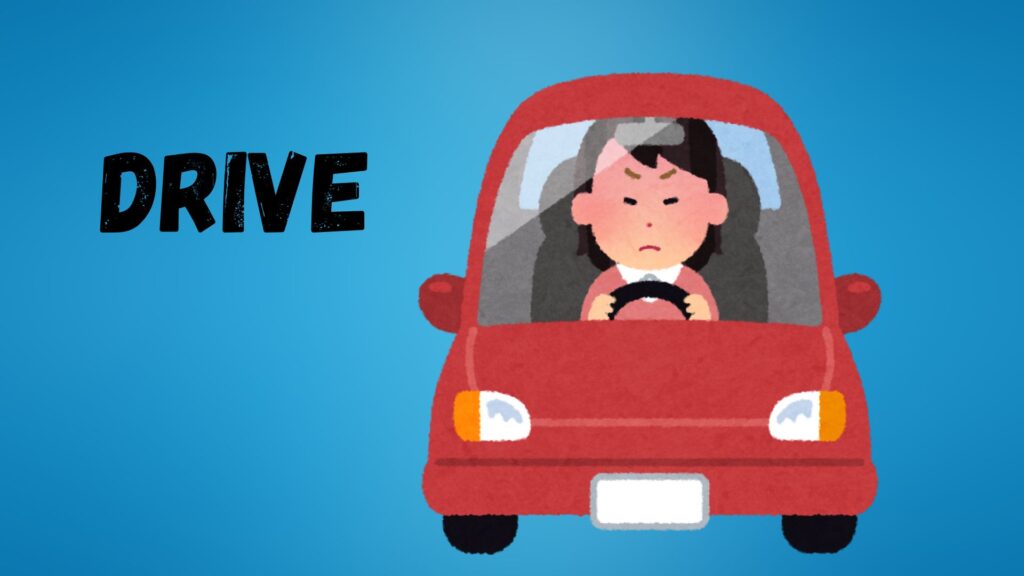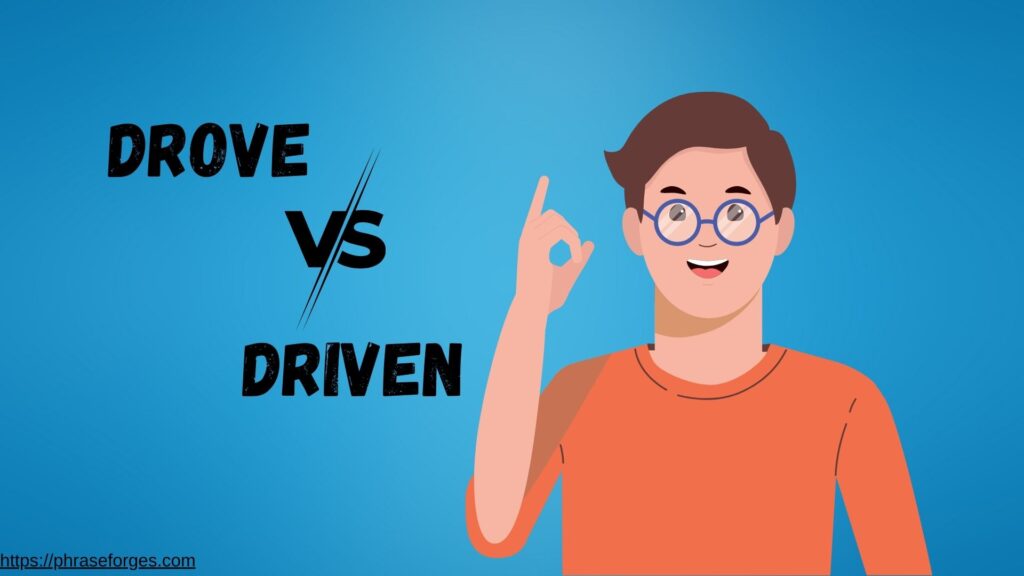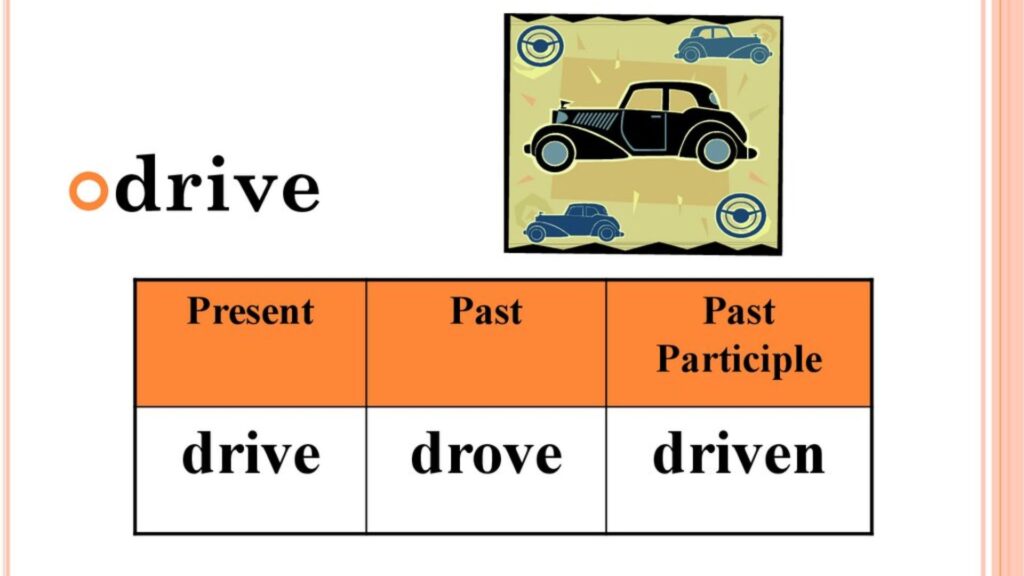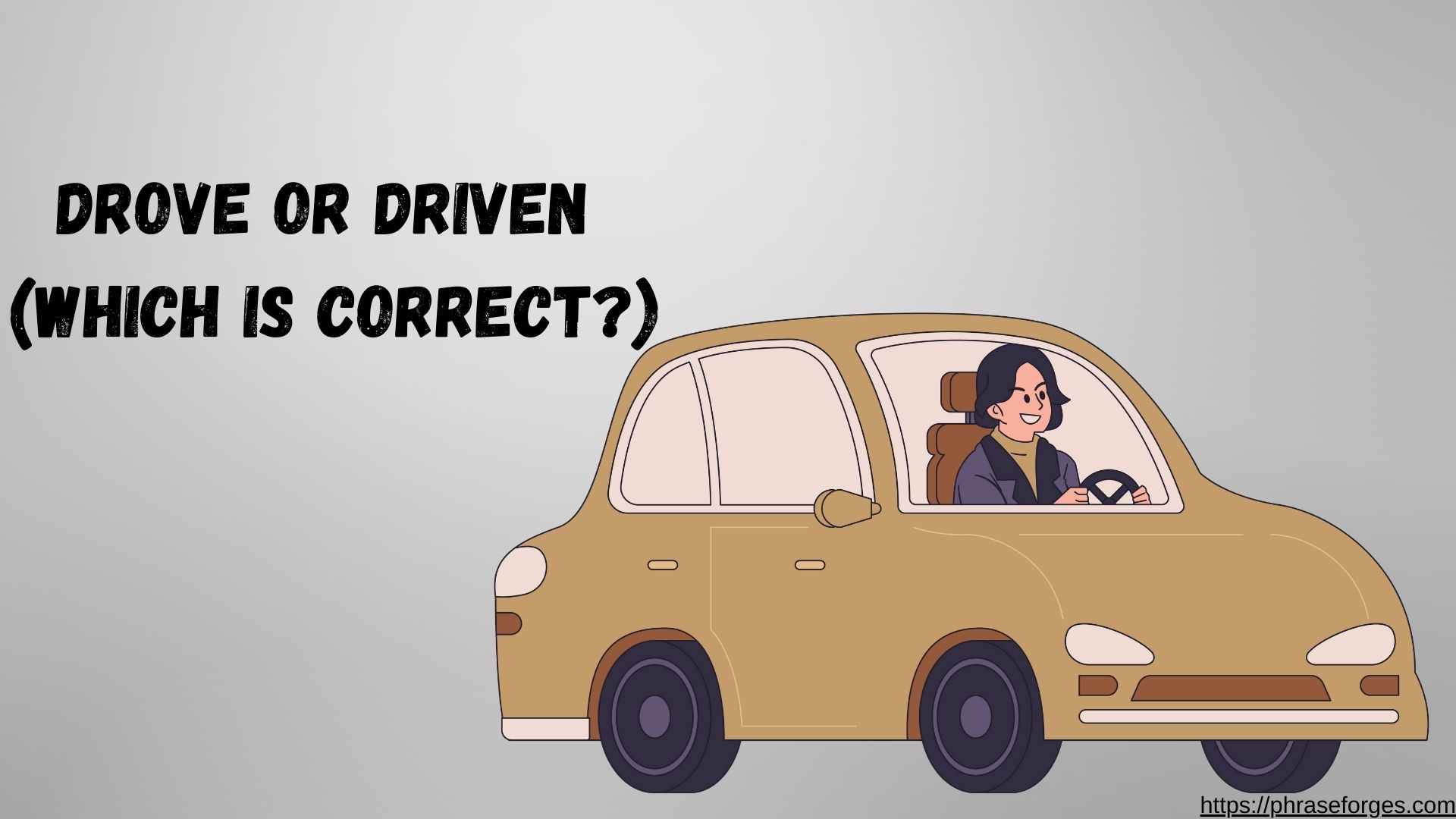Knowing whether to use “drove” or “driven” can trip up even confident English speakers. Both words come from the verb “drive,” but they’re not interchangeable. The key difference lies in their verb tense and how they’re used within a sentence. Let’s break it down simply with real-life examples and a few easy grammar hacks to make things stick.
Understanding the Verb “Drive”

The verb “drive” means to operate a vehicle, to move something forward with force, or even to motivate. But when we’re talking about past tenses, things get a bit more specific.
Here’s the full drive verb conjugation table:
| Tense | Verb Form |
|---|---|
| Base form | drive |
| Simple past | drove |
| Past participle | driven |
| Present participle | driving |
| 3rd person singular | drives |
Now let’s zoom in on the tricky two: drove and driven.
What Does “Drove” Mean?
“Drove” is the simple past tense of the verb “drive.” It describes something that already happened in the past, and it doesn’t need a helping (auxiliary) verb.
✅ Correct Example:
“I drove to work this morning.”
In this sentence:
- The action is complete
- The subject (“I”) is doing the action
- No helping verb is needed
💬 Email Scenario Using “Drove”
Subject: Quick Follow-up After Yesterday
Hi Rachel,
I drove to the client’s office yesterday afternoon to drop off the final project files. They seemed pleased with everything and asked for a few minor adjustments. I’ll make those today and resend.
Best,
James
This is a classic example of simple past tense clear, direct, and focused on a completed action.
What Does “Driven” Mean?
“Driven” is the past participle form of “drive.” This means it’s used in perfect tenses, usually with auxiliary verbs like has, have, or had. You can’t use “driven” by itself as the main verb in a past-tense sentence.
✅ Correct Example:
“She has driven across five countries in Europe.”
In this sentence:
- “Has” is the auxiliary verb
- “Driven” is the past participle
- Together, they create the present perfect tense
⛔ Incorrect: “She driven to the store.”
✅ Corrected: “She has driven to the store.”
Drove vs. Driven: Quick Grammar Rule

| Use “Drove” When… | Use “Driven” When… |
|---|---|
| You’re describing a simple past action | You’re using it with a helping verb (have/had) |
| No auxiliary verb is needed | It’s part of the perfect tense (have driven) |
| Example: “He drove last night.” | Example: “He had driven for hours by sunrise.” |
Common Grammar Mistakes (and How to Fix Them)
Many people misuse these forms when trying to sound formal or when trying to recall school grammar lessons they’ve half-forgotten.
Here are some classic blunders and the grammar corrections that fix them:
| Incorrect | Why It’s Wrong | Correct Form |
|---|---|---|
| “I driven home after work.” | Missing auxiliary verb | “I have driven home after work.” |
| “He had drove the truck before.” | “Drove” shouldn’t be used with “had” | “He had driven the truck before.” |
| “We have drove all night.” | “Drove” is simple past, doesn’t pair with “have” | “We have driven all night.” |
| “She driven herself crazy studying.” | Missing helping verb | “She has driven herself crazy studying.” |
To remember this easily, think of this simple formula:
Have/Had + Past Participle (Driven) = ✅
How to Use Driven Correctly
Let’s dive into a few examples that show off how to use driven correctly in professional or everyday situations.
📝 Team Message Using “Driven”
Hey Team,
I just wanted to let you know that I have driven down to the supplier’s warehouse to confirm inventory for Monday’s shipment. Everything looks good, and they’re prepping the order now.
Thanks,
Aisha
This example uses the present perfect tense, combining “have” and “driven” to show a recent action with current relevance.
Past Perfect: Had Driven
Want to get a bit more advanced? Here’s how to use “had driven” the past perfect tense.
This tense shows that one past action happened before another.
💡 Example:
“By the time we arrived at the airport, she had driven for over six hours.”
You’re sequencing past events:
- She had driven (action 1 – earlier)
- We arrived (action 2 – later)
Drive Conjugation Explained with Real-Life Dialogue
Kevin: “Hey, how was your trip?”
Lena: “Exhausting. I drove 400 miles in one day!”
Kevin: “Wow. I thought you’d have driven halfway and stopped overnight.”
Lena: “That was the plan… but I just wanted to get home.”
Here, you can see both simple past and past participle used naturally.
Why Drive Is an Irregular Verb
“Drive” is what we call an irregular verb, meaning it doesn’t follow the regular -ed rule for past tense. You can’t just add “-ed” and call it a day.
Compare with a regular verb:
| Regular Verb | Past Tense | Past Participle |
|---|---|---|
| talk | talked | talked |
| jump | jumped | jumped |
| drive (irregular) | drove | driven |
Drive Past Tense vs. Perfect Tense (Quick Recap)

Let’s compare the two key verb tenses side by side.
| Tense | Form | Example |
|---|---|---|
| Simple Past | drove | “I drove to work yesterday.” |
| Present Perfect | have/has + driven | “I have driven this route many times.” |
| Past Perfect | had + driven | “She had driven for hours before the crash.” |
Final Thoughts: Drove vs. Driven Grammar Made Easy
To recap:
- Use “drove” when talking about a completed action in the past with no auxiliary verb.
- Use “driven” only when it’s paired with a helping verb like “has,” “have,” or “had.”
- They both come from the same root verb “drive”, but their usage depends on the tense and structure of your sentence.
- If you’re building a sentence and asking, “driven or drove?”, look for the auxiliary verb first.
Whether you’re correcting your own writing or helping someone else, knowing the difference between drove and driven is one of those small details that makes your English sound polished and professional.

